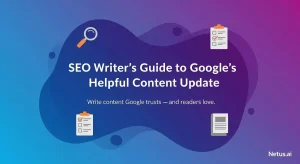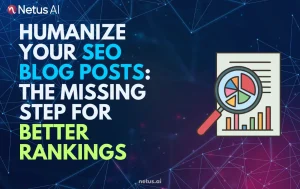
Why Google’s ‘Who, How, Why’ Framework Matters for EEAT | NetusAI
Why Google’s ‘Who, How, Why’ Framework Matters for EEAT AI can create articles in seconds. But here’s the truth: speed is not enough. Google wants
How to Write a Recipe for Cookbooks: Expert Tips and Guidelines

Content writer and editor for Netus.AI
How to Write a Recipe for Cookbooks. In today’s rapidly evolving publishing landscape, the potential for plagiarism in various forms has increased. Writing recipes, however, presents a unique challenge, as the transfer of knowledge between generations often leads to similarities in content. To create an original and engaging recipe while steering clear of plagiarism, consider the following pointers:
By adhering to these guidelines, you can generate well-written and original recipes, effectively avoiding plagiarism and creating valuable content for your audience. With a focus on accuracy, organization, and a unique personal touch, your recipe becomes the perfect guide for readers eager to explore the culinary world.
The topic of recipe plagiarism raises various opinions, as some believe that recipes cannot be owned, while others argue that they can be considered intellectual property. Although copyright rules protect numerous types of intellectual properties, such as artwork and music, the status of recipes remains contentious.
In the United States, recipes are generally not covered by copyright laws, as they are seen as mere lists of ingredients. However, copyright protection may extend to the literary aspects of a recipe, such as descriptions, explanations, illustrations, and specific writing styles used in cookbooks or food blogs. This enables cookbook authors and food bloggers to seek copyright protection for their unique presentation of recipes rather than the recipes themselves.
While chefs and culinary professionals may prefer to copyright the recipes as a whole, the current approach focuses more on protecting the creative expression used in presenting these recipes. This ensures that writers and content creators are able to protect their work while still allowing room for the sharing and adaptation of recipes in the culinary world. By understanding and adhering to these copyright rules, cookbook authors, food bloggers, and publishers can avoid legal pitfalls and maintain the highest level of originality in their work.
While recipes play a significant role in the culinary world, they cannot be protected under copyright laws like other creative works. Chefs cannot claim intellectual property rights over their recipes, even though some, like KFC’s 11 Herbs and Spices, are held as trade secrets. Some actions can be taken within the food community to address recipe plagiarism, but comprehensive legal protection is lacking.
Cookbook authors and food bloggers can better protect their written content from being copied, if they can provide evidence of originality in words or images. However, establishing ownership over individual recipes is quite challenging. This is because plagiarists can make minor alterations or change the presentation method before republishing a recipe. As a result, proving copyright infringement in the realm of cookbooks and recipe writing becomes complicated.
Due to the absence of adequate legal support and the difficulties in verifying recipe plagiarism, many such cases remain unresolved.
Since many recipes are age-old, it’s crucial for writers to find creative ways to represent these recipes. They should focus on their words and presentation to make a difference, even when dealing with traditional recipes.
Food bloggers and cookbook authors understand the importance of using images and illustrations. Not only do they enhance the appeal of their work, but they also contribute to making it stand out. While it may not be possible to protect a recipe’s steps or ingredients via copyright, the images and illustrations used in the cookbook can be protected. To avoid copyright infringement, writers should utilize their own photos, which simultaneously safeguard their work from being copied or plagiarized.
A copyright checker can help verify that writers are not violating copyright laws and detect any copied or duplicate content in their work. Although cookbook authors and bloggers may not obtain copyright protection for recipes’ steps, their cooking videos and podcasts do receive such protection. As a result, the content of these multimedia formats is secure.
Since copyright protection for recipes might be challenging to obtain, many writers might not seek legal assistance. However, if a celebrity chef or writer has copyrighted content in their cookbook or food blog, such issues come to light.
As writers don’t have access to full copyright protection for their recipes, they should rely on their creativity while writing. Using a plagiarism checker before publishing the cookbook can be beneficial. The Copyleaks plagiarism checker, powered by advanced AI and Machine Learning technology, offers accurate real-time results, making it easier to identify anyone using dishonest methods to avoid plagiarism.
Additionally, Optical Character Recognition (OCR) technology can be employed to scan physical copies of cookbooks and check for any plagiarized content. This approach not only prevents potential legal troubles under copyright laws but also aids in safeguarding one’s work from plagiarism.

Why Google’s ‘Who, How, Why’ Framework Matters for EEAT AI can create articles in seconds. But here’s the truth: speed is not enough. Google wants

SEO Writer’s Guide to Google’s Helpful Content Update Keeping up with Google’s algorithm changes can feel like a relentless game of whack-a-mole. Just when you

Can AI Content Be Safe for SEO in 2025? Let’s start with the question of keeping every content strategist, SEO pro and blogger awake at

Humanize Your SEO Blog Posts: The Missing Step for Better Rankings You’ve done everything by the book. Your keyword research is impeccable. Your meta descriptions

How to Pass AI Detection Tests as an SEO Writer Let’s paint a familiar picture. You’ve just finished a blog post. The headline is sharp,

Why Your AI SEO Blog Isn’t Ranking (And How to Fix It) You embraced AI for your blog. The promise was intoxicating: high-quality content, published
@ 2024 Netus AI.